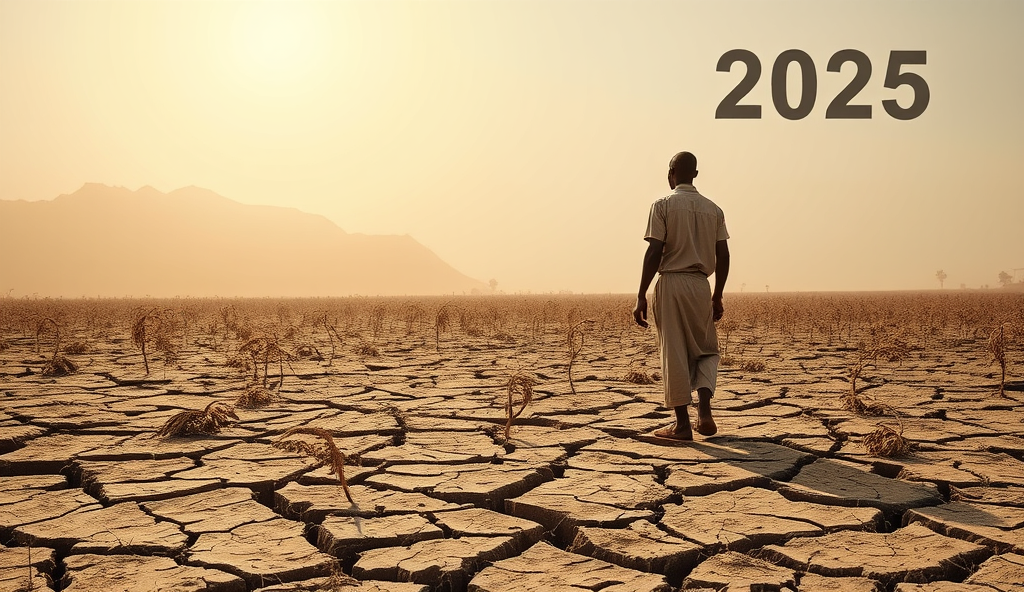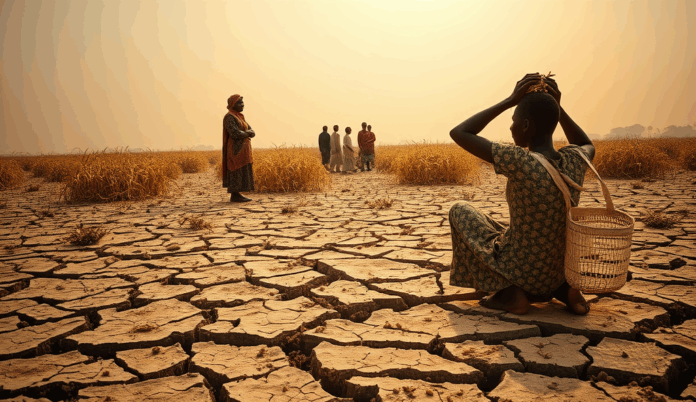Introduction to Crop Failure in Nigeria
Crop failure in Nigeria has become a growing concern, with agricultural losses in Nigeria estimated at over ₦1.2 trillion annually due to poor harvests. Farmers across regions like the North and Middle Belt face declining yields, threatening food security and livelihoods.
Factors like unpredictable weather patterns and soil degradation reducing farm productivity contribute significantly to these challenges. For instance, maize production dropped by 15% in 2023 due to prolonged droughts in key farming states.
Understanding these causes is crucial as climate change effects on Nigerian agriculture intensify. The next section will explore how shifting weather conditions further disrupt farming cycles and worsen crop failures nationwide.
Key Statistics

Climate Change and Unpredictable Weather Patterns
Crop failure in Nigeria has become a growing concern with agricultural losses in Nigeria estimated at over ₦1.2 trillion annually due to poor harvests.
Shifting rainfall patterns and rising temperatures are disrupting traditional farming calendars across Nigeria, with the 2023 drought in Northern states reducing maize yields by 15% as mentioned earlier. Farmers now face shorter growing seasons and more frequent extreme weather events, making crop planning increasingly difficult.
The Nigeria Meteorological Agency reported a 20% decline in annual rainfall since 2010 in key agricultural zones like Kaduna and Kano. These erratic conditions directly contribute to agricultural losses in Nigeria by damaging crops during critical growth stages or preventing planting altogether.
As climate change effects on Nigerian agriculture intensify, degraded soils further compound these challenges—a problem we’ll examine next. The combination of weather instability and poor land quality creates a vicious cycle for farmers struggling to maintain productivity.
Poor Soil Quality and Degradation
The Nigeria Meteorological Agency reported a 20% decline in annual rainfall since 2010 in key agricultural zones like Kaduna and Kano.
Compounding the challenges of erratic weather, Nigeria’s agricultural productivity suffers from widespread soil degradation, with 60% of farmland in Northern Nigeria now classified as severely degraded according to FAO 2023 data. Intensive farming without proper crop rotation has depleted vital nutrients, leaving soils unable to support healthy plant growth even when rainfall patterns are favorable.
The economic impact of failed harvests in Nigeria worsens as degraded soils require more fertilizers to achieve modest yields, pushing input costs beyond what smallholder farmers can afford. In states like Sokoto and Katsina, maize production has dropped by 30% over the past decade due to declining soil fertility exacerbated by climate change effects on Nigerian agriculture.
This soil crisis creates a dangerous dependency cycle where farmers struggling with low crop yields often overuse chemical inputs, further damaging land quality. As we’ll explore next, these challenges are worsened by inadequate access to quality seeds and modern farming inputs that could help restore soil health.
Inadequate Access to Quality Seeds and Inputs
Nigeria's agricultural productivity suffers from widespread soil degradation with 60% of farmland in Northern Nigeria now classified as severely degraded according to FAO 2023 data.
Nigeria’s soil degradation crisis is worsened by farmers’ limited access to certified seeds and appropriate inputs, with only 20% of smallholders using improved seeds according to NASC 2023 reports. Many rely on recycled seeds with declining germination rates, further reducing yields in already stressed farmlands across states like Kano and Kaduna.
The high cost of quality inputs like drought-resistant seeds and organic fertilizers puts them beyond reach for 70% of small-scale farmers, perpetuating low productivity cycles. Government subsidy programs often fail to reach rural farmers, forcing them to depend on substandard alternatives that worsen soil health.
These input shortages leave crops vulnerable to additional stresses, setting the stage for increased pest and disease outbreaks that we’ll examine next. Without proper seeds and soil amendments, even favorable weather conditions cannot guarantee successful harvests in Nigeria’s degraded farmlands.
Pests and Diseases Affecting Crops
Nigeria’s weakened crops already struggling due to poor soil and low-quality seeds face heightened vulnerability to pests like fall armyworms and diseases like cassava mosaic virus which caused 90% yield losses in Benue in 2022.
Nigeria’s weakened crops, already struggling due to poor soil and low-quality seeds, face heightened vulnerability to pests like fall armyworms and diseases like cassava mosaic virus, which caused 90% yield losses in Benue in 2022. These outbreaks are exacerbated by climate shifts and inadequate pest control measures, with smallholders losing up to 40% of harvests annually according to NABDA.
Farmers relying on recycled seeds or untreated planting materials unknowingly reintroduce pathogens, worsening infestations in states like Taraba and Niger. Limited access to affordable pesticides or resistant seed varieties leaves many with manual removal as their only defense, a method proven ineffective against large-scale invasions.
Without integrated pest management strategies, these challenges compound existing soil degradation issues, setting the stage for deeper exploration of how modern farming techniques could mitigate losses. The next section examines how knowledge gaps and technology adoption barriers further hinder productivity.
Limited Access to Modern Farming Techniques
Addressing crop failure in Nigeria requires a multi-faceted approach combining climate-smart agriculture with improved access to inputs like drought-resistant seeds.
Despite Nigeria’s agricultural potential, only 5% of farmers use mechanized equipment, leaving most reliant on outdated tools that worsen soil degradation and reduce yields, as reported by the National Bureau of Statistics. Smallholders in states like Kano and Kaduna struggle with manual tilling, which accelerates erosion while failing to control pests or diseases effectively.
Adoption of precision farming techniques remains low, with less than 10% of rice farmers using improved seed varieties or soil sensors, perpetuating cycles of low crop yields in Northern Nigeria. Government subsidies for modern tools rarely reach rural communities, forcing farmers to depend on traditional methods that exacerbate climate change effects on Nigerian agriculture.
This technological gap compounds irrigation challenges, as inefficient water management further strains already degraded soils—a problem explored in the next section. Without scalable solutions, food insecurity due to poor harvests will persist, particularly among small-scale producers.
Insufficient Irrigation Systems
Nigeria’s reliance on rain-fed agriculture leaves 80% of crops vulnerable to drought, particularly in northern states like Sokoto and Yobe, where erratic rainfall patterns disrupt planting cycles. The FAO reports that only 1% of arable land uses modern irrigation, forcing farmers to abandon fields during dry spells.
Traditional flood irrigation wastes 60% of water resources while failing to reach root zones efficiently, worsening soil degradation in regions like Kebbi’s rice belt. Solar-powered drip systems could boost yields by 40%, but high upfront costs and lack of training limit adoption among smallholders.
These irrigation gaps amplify food insecurity due to poor harvests, highlighting the need for policy interventions—a focus of the next section on government agricultural support. Without scalable water management solutions, climate change effects on Nigerian agriculture will intensify.
Government Policies and Agricultural Support
To address irrigation gaps and food insecurity, Nigeria’s government launched the National Agricultural Technology and Innovation Policy (NATIP), aiming to expand modern irrigation coverage to 10% of arable land by 2025. However, implementation lags in states like Sokoto, where only 15% of promised solar-powered drip systems reached smallholders due to funding delays and logistical bottlenecks.
Subsidies for irrigation equipment under the Anchor Borrowers’ Program reduced costs by 30%, yet many farmers in Kebbi remain unaware of these initiatives, perpetuating reliance on wasteful flood irrigation. The FAO recommends scaling up training programs alongside subsidies to improve adoption rates and combat soil degradation in high-risk regions.
While these policies show potential, inconsistent execution and corruption divert resources, exacerbating crop failure risks—a challenge compounded by broader economic factors explored next. Market instability further undermines farmers’ ability to invest in resilient practices, creating a cycle of vulnerability.
Economic Factors and Market Instability
Nigeria’s inflation rate, which hit 28.9% in December 2023, has drastically increased input costs for farmers, with fertilizer prices rising by 200% in some northern states like Kano. This economic pressure forces many smallholders to abandon climate-smart practices discussed earlier, reverting to cheaper but unsustainable methods that worsen soil degradation and crop failure risks.
Currency volatility further disrupts agricultural planning, as the naira’s 40% depreciation in 2023 made imported irrigation equipment and hybrid seeds unaffordable despite government subsidies. A Kebbi rice farmer survey revealed 68% couldn’t replant after floods due to these cost barriers, perpetuating the vulnerability cycle mentioned in prior sections.
These market shocks intersect with policy gaps—like delayed NATIP implementation—creating a perfect storm where economic instability amplifies climate and infrastructural challenges. As we’ll explore in closing, breaking this cycle requires coordinated interventions addressing both systemic and immediate farmer needs.
Conclusion on Addressing Crop Failure in Nigeria
Addressing crop failure in Nigeria requires a multi-faceted approach, combining climate-smart agriculture with improved access to inputs like drought-resistant seeds. Farmers in states like Kano and Kaduna have seen yield improvements of up to 30% by adopting these methods alongside proper irrigation techniques.
Government policies addressing crop failure must prioritize soil health management and farmer education programs to combat soil degradation reducing farm productivity. Initiatives like the Anchor Borrowers’ Program show promise but need wider implementation to significantly impact food insecurity due to poor harvests nationwide.
Looking ahead, collaborative efforts between researchers, policymakers, and farming communities will be crucial in developing localized solutions for Nigeria’s diverse agricultural zones. The economic impact of failed harvests can be mitigated through such coordinated action, ensuring food security for Nigeria’s growing population.
Frequently Asked Questions
What practical steps can I take to improve soil quality and prevent crop failure?
Practice crop rotation and use organic compost to restore nutrients—FAO recommends planting legumes like cowpea to naturally enrich degraded soils.
How can small-scale farmers afford drought-resistant seeds to combat climate change effects?
Join farmer cooperatives to access bulk purchases and government subsidy programs like the Anchor Borrowers' Program for discounted quality seeds.
What low-cost irrigation methods work best for farmers facing water shortages?
Use DIY drip irrigation with recycled bottles or adopt the Nigerian-developed 'Koolgrow' solar-powered kits for efficient water use in dry regions.
How can I protect my crops from pests without expensive chemicals?
Apply neem oil spray (mix 50ml neem oil with 1 liter water) and intercrop with pest-repelling plants like marigold to reduce infestations naturally.
Where can I get training on modern farming techniques to increase yields?
Contact your state’s Agricultural Development Project (ADP) office or access free online courses via the National Agricultural Extension and Research Liaison Services (NAERLS) portal.


